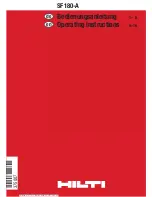
34
EnGLIsH
nOTE:
The worklight is for lighting the immediate work surface
and is not intended to be used as a flashlight.
Keyless Single Sleeve Chuck (Fig. G–I)
WARNING:
Do not attempt to tighten drill bits (or
any other accessory) by gripping the front part of the
chuck and turning the tool on. Damage to the chuck
and personal injury may result. Always lock off trigger
switch and disconnect tool from power source when
changing acces sories.
WARNING:
Always ensure the bit is secure before starting
the tool. A loose bit may eject from tool causing possible
personal injury.
Your tool features a keyless chuck
6
with one rotating sleeve for
one-handed operation of the chuck. To insert a drill bit or other
accessory, follow these steps.
1. Turn tool off and disconnect tool from power source.
2. Grasp the black sleeve of the chuck with one hand
and use the other hand to secure the tool. Rotate the
sleeve counterclockwise far enough to accept the
desired accessory.
3. Insert the accessory about 19 mm into the chuck and
tighten securely by rotating the chuck sleeve clockwise with
one hand while holding the tool with the other. Your tool is
equipped with an automatic spindle lock mechanism. This
allows you to open and close the chuck with one hand.
Be sure to tighten chuck with one hand on the chuck sleeve and
one hand holding the tool for maximum tightness.
To release the accessory, repeat steps 1 and 2 above.
OPERATION
Instructions for Use
WARNING:
Always observe the safety instructions and
applicable regulations.
WARNING: To reduce the risk of serious personal
injury, turn tool off and disconnect battery pack
before making any adjustments or removing/
installing attachments/accessories or when making
repairs.
An accidental start-up can cause injury.
Proper Hand Position (Fig. C)
WARNING:
To reduce the risk of serious personal injury,
ALWAYS
use proper hand position as shown.
WARNING:
To reduce the risk of serious personal
injury,
ALWAYS
hold securely in anticipation of a
sudden reaction.
Proper hand position requires one hand on the main handle
9
and one hand on the battery pack.
Screwdriver Operation (Fig. D)
1. Select the desired speed/torque range using the dual
range gear selector to match the speed and torque of the
planned operation.
2. Turn the torque adjustment collar
3
to the desired position.
Lower numbers indicate lower torque settings; higher
numbers indicate higher torque settings.
3. Insert the desired fastener accessory into the chuck as you
would any drill bit.
4. Make some practice runs in scrap or on unseen areas to
determine the proper position of the clutch collar.
5. Always start with lower torque settings, then advance to
higher torque settings to avoid damage to the workpiece
or fastener.
Drill Operation (Fig. E)
WARNING:
To reduce the risk of serious personal injury,
turn tool off and disconnect tool from power source
before making any adjustments or removing/installing
attachments or accessories.
WARNING: TO REDUCE THE RISK OF PERSONAL
INJURY, ALWAYS
ensure workpiece is anchored or
clamped firmly. If drilling thin material, use a wood “back-
up” block to prevent damage to the material.
1. Turn the collar
3
to the drill symbol.
2. Select the desired speed/torque range using the gear shifter
to match the speed and torque to the planned operation.
3. For Wood, use twist bits, spade bits, power auger bits or
hole saws. For Metal, use high-speed steel twist drill bits
or hole saws. Use a cutting lubricant when drilling metals.
The exceptions are cast iron and brass which should be
drilled dry.
4. Always apply pressure in a straight line with the bit. Use
enough pressure to keep drill biting, but do not push hard
enough to stall the motor or deflect the bit.
5. Hold tool firmly with both hands to control the twisting
action of the drill. If model is not equipped with side handle,
grip drill with one hand on the handle and one hand on the
battery pack.
CAUTION:
Drill may stall if overloaded causing a sudden
twist. Always expect the stall. Grip the drill firmly to control
the twisting action and avoid injury.
6.
IF DRILL sTaLLs,
it is usually because it is being overloaded
or improperly used.
RELEasE TRIGGER IMMEDIaTELY,
remove drill bit from work, and determine cause of stalling.
DO nOT CLICk TRIGGER On anD OFF In an aTTEMPT
TO sTaRT a sTaLLED DRILL — THIs Can DaMaGE
THE DRILL.
7. To minimize stalling or breaking through the material,
reduce pressure on drill and ease the bit through the last
fractional part of the hole.
8. Keep the motor running when pulling the bit back out of a
drilled hole. This will help prevent jamming.
9. With variable speed drills there is no need to center punch
the point to be drilled. Use a slow speed to start the hole
and accelerate by squeezing the trigger harder when the
hole is deep enough to drill without the bit skipping out.
















































